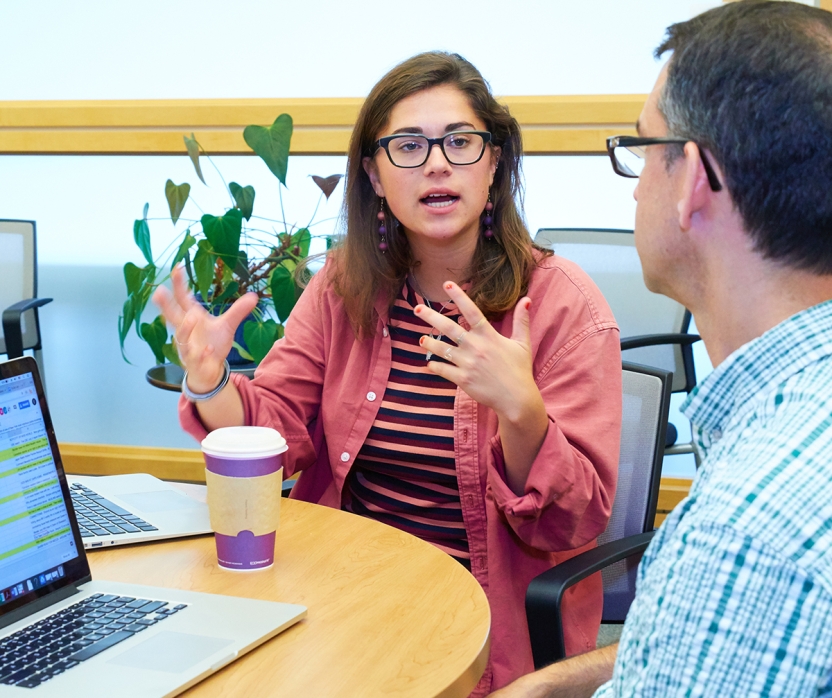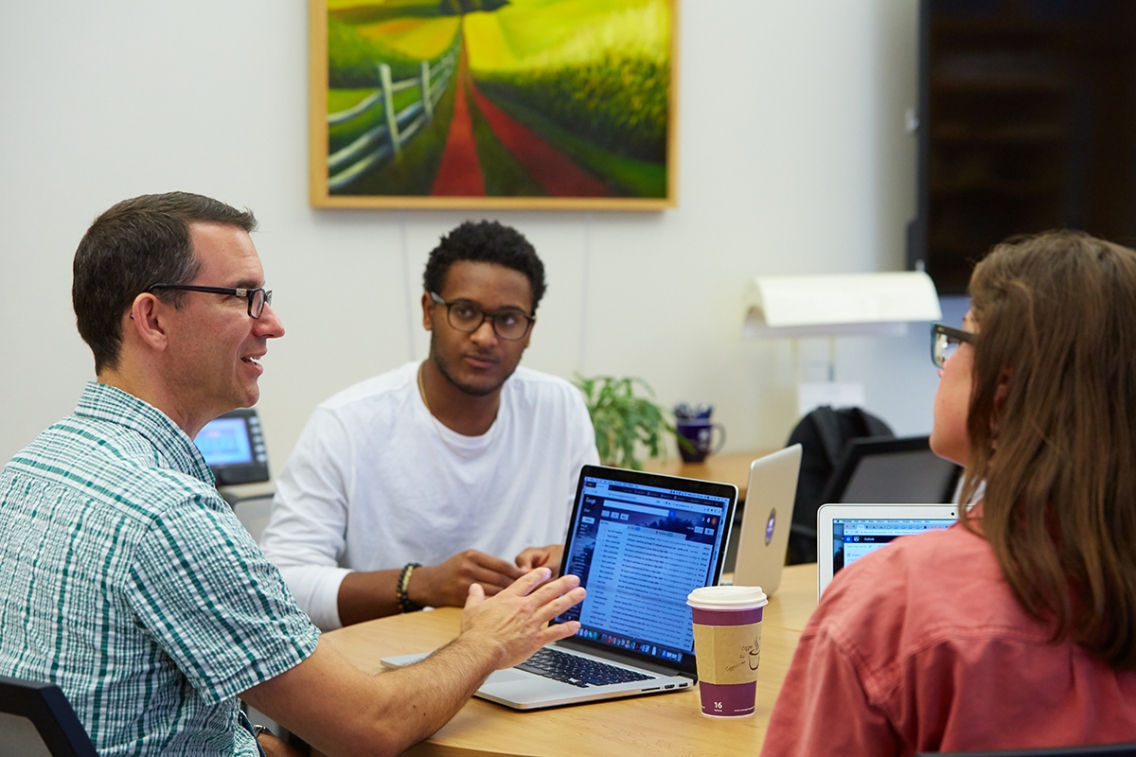Faculty, Students Study Muslim Portrayals in Media

MIDDLEBURY, Vt. – For rising seniors Julien Souffrant and Emily Stabler, summer research offers them a chance to roll up their sleeves and make a tangible contribution on a hot-button issue. Both are assisting political science professor Erik Bleich as part of his ongoing Media Portrayals of Minorities Project.
“I was really looking for something that I could say, ‘This is public. This made a difference,” said Souffrant, an international politics and economics major.
For Stabler, who chose political science for its focus on contemporary issues, participation in the project is important “because it’s current and because it matters—it really matters the way that minority groups are portrayed.”
This summer, work focuses on media portrayals of Muslims, a topic Bleich has been investigating for several years through a series of articles (many coauthored with students) and a soon-to-be-completed book. Bleich, Souffrant, and Stabler are coauthoring a paper based on a surprising finding: Newspaper coverage of Muslims trends positive when the topic is Muslim devotion. The paper will soon go to the journal Religions for consideration in a special issue on “Anti-Muslim Racism and the Media.” (Update-the paper was published Aug. 16, 2018.)
This kind of close collaboration and mentoring, said Bleich, “gets students to think of themselves as people who are contributing to knowledge and finding out new things that nobody else knows with methods that are cutting-edge. It allows them to answer pressing questions that they have as citizens and individuals and then use that to speak to a broader audience.”

Professor Erik Bleich, director of the Media Portrayals of Minorities Project, meets with student researchers Julien Souffrant ’19 and Emily Stabler ’19.
Bleich launched the Media Portrayals of Minorities Project in 2012, out of a desire to test opinions and assumptions against something more quantifiable.
“I had just written a piece on what is Islamophobia and how do we measure it, and was also finishing my book The Freedom to Be Racist? The thing I noticed … is that there were a lot of discussions on things like hate speech and Islamophobia but not much in the way of concrete measures,” said Bleich. “So how do we see it actually in front of us as opposed to us talking about it in theory?”
One such measure, he reasoned, could be found by analyzing headlines. The results were surprising.
“We discovered fairly quickly that there really wasn’t much in the way of overt Islamophobia articulated in headlines… . We expected that on balance there would be many more negative headlines than positive headlines. It turned out that there were essentially an even number of negative headlines and positive headlines.”
Their takeaway at that time? “That maybe some of the case that was being made that the media was relentlessly negative was overstated.”
As Bleich has continued his investigations, techniques in the Media Portrayals of Minorities Project lab have become more sophisticated. In 2012, the lab used solely what Bleich calls “human coding”: each researcher read headlines, one at a time, and analyzed them for tone. In recent years, the lab has embraced computer-assisted methods of “lexical sentiment analysis” (analyzing texts for tone) and “collocation analysis” (searching for words found in close proximity) to parse the complete text of hundreds of thousands of articles, often stretching over decades. Bleich has partnered in this work with Maurits van der Veen, a professor of government with a background in computer science at the College of William and Mary.
For his recent work on Muslims and the media, Bleich has parsed over a million texts.
The change in methodology has led to new findings, sometimes adding to, sometimes overturning previous conclusions.
“Our early research showed that Muslims were not portrayed negatively in headlines, but rather fairly neutrally. This surprised us,” said Bleich. “Our later work surprised us when we learned just how much negativity is associated with Muslims in full text articles, which was revealed with our new computer-assisted methods.”
Just how much negativity? Bleich’s current research finds that the average article mentioning Muslims—looked at in a cross-section of American, Canadian, British, and Australian newspapers over a 20-year period—is “more negative than approximately 82 percent of all articles” in a random sample across all topics.
The average article in the “Muslims and devotion” subset, by contrast, is more positive than 52 percent of all articles in the random sample.
“One of the really cool parts of this research process is we are able to crunch so much data and able to find these really, really macro trends,” said Stabler.
Students interested in joining the lab typically enroll in what Bleich calls his winter term “boot camp” to learn the methodologies. They then apply these skills to their own research projects, which have ranged from media portrayals of Latinos to how race plays into media portrayals of mass shooters to comparisons of media portrayals of sexual misconduct in the Clinton and Trump eras.
Stabler and fellow lab member Rand Jibril ’20 were intrigued by a Washington Post opinion piece claiming that racism had led to far more media coverage for Syrian than for African refugees. They parsed over 51,000 articles over a 10-year period and found that coverage had been roughly equal.
“What’s interesting is that it shows that people make assumptions, and depending on how you’re consuming your news, you remember certain things and don’t remember others,” said Stabler. “It shows that we should be careful in the assumptions we make.”
Many “boot campers” continue in the lab over one or more semesters.
“This spring we did a lot of number crunching,” said Souffrant. “It involved having the code to be able to run the program, and then looking at the raw numbers, looking at the different regressions, different valence scores of different subsets… . There was a lot of going through Strata [statistics software] and trying to find interesting things, seeing the things that did or didn’t match, and then looking into that.”
“You can go far down the rabbit hole,” Stabler observed.
“Human coding” still has an important place in the process. Bleich, Souffrant, and Stabler spent much of the summer reading, dissecting, and discussing a random sampling of 100 “Muslims and devotion” articles as a way to confirm or challenge what they’d found through their computer-assisted analysis.
“We expected, despite the apparent neutrality indicated in our quantitative analysis, to find a bulk of articles discussing and critiquing the cultural ‘otherness’ of Islamic faith practices, the intense religiosity of Muslims (according to scholars, perceived to be in conflict with the secularism of Western societies), disproportionate coverage of scandalous/violent events involving Muslims, and generally, just an underlying negativity that we suspected the computer may have failed to detect,” said Stabler.
Instead, their reading confirmed their earlier findings.
While Bleich’s work as a political scientist embraces a range of methodologies (including a recent series of presentations on the theme “What Is Hate Speech?”), the kind of number-driven analysis exemplified in the Media Portrayals of Minorities Project reveals deeply held core beliefs.
“Partly,” he said, “it’s about just the time we live in where everybody is just saying the first thing that comes to the tip of their brain; whether it’s true or not doesn’t seem to matter anymore. For me, that’s a very dangerous world to live in. Partly I’m trying to communicate to my students to delve more deeply into the facts in order to get this better understanding of the world that we live in. And part is that you’re never at the point where you should be willing to say, ‘I now have the final answer. I can stop thinking about it for all time. I’m done.’”
By Gaen Murphree; Photos by Todd Balfour
*This story was updated on Aug. 17, 2018.

